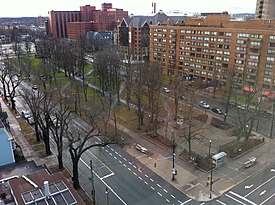Victoria Park, Halifax, Nova Scotia: Difference between revisions
Appearance
Content deleted Content added
Hantsheroes (talk | contribs) No edit summary |
Hantsheroes (talk | contribs) |
||
| Line 42: | Line 42: | ||
File:WalterScottVictoriaParkHalifaxNovaScotia.jpg|Sir [[Walter Scott]] by Sir [[Francis Chantrey]] (1932) |
File:WalterScottVictoriaParkHalifaxNovaScotia.jpg|Sir [[Walter Scott]] by Sir [[Francis Chantrey]] (1932) |
||
File:WilliamAlexanderMonumentVictoriaParkHalifaxNovaScotia.jpg|[[William Alexander, 1st Earl of Stirling|William Alexander Monument]], built of stones from his [[Menstrie Castle]] (1957) |
File:WilliamAlexanderMonumentVictoriaParkHalifaxNovaScotia.jpg|[[William Alexander, 1st Earl of Stirling|William Alexander Monument]], built of stones from his [[Menstrie Castle]] (1957) |
||
File:OlandMemorialFountain.png| |
File:OlandMemorialFountain.png|Olandl's Memorial Fountain to his wife (1966) |
||
</gallery> |
</gallery> |
||
Revision as of 02:07, 22 January 2019
This article needs additional citations for verification. (January 2017) |
| Victoria Park | |
|---|---|
 Victoria Park | |
 | |
| Type | Public park |
| Location | Halifax, Nova Scotia |
| Operated by | Halifax Regional Municipality |
Victoria Park is an urban park on Spring Garden Road in Halifax, Nova Scotia, Canada, across from the Halifax Public Gardens.
The North British Society erected various monuments and statues: Rabbie Burns, Sir Walter Scott and William Alexander, 1st Earl of Stirling.[1]
At the south end of the park Sidney Culverwell Oland created the Linda Oland Memorial Fountain in memory of his wife (1966).[2]
Robert Burns statue
George A. Lawson created the memorial to Robert Burns in Ayr, inaugurated in 1892. Other versions were circulated to Dublin, Melbourne, Montreal, Winnipeg, Halifax and elsewhere. The statue was cast in Halifax in 1919. On the base of the Rabbie Burns statue are commemorations of the following poems:
- Front: The Cotter’s Saturday Night – “From scenes like these old Scotia’s grandeur springs.” (1786)[3]. A "Cotter" (a peasant given a Cottage in exchange for labour) and his family relax on Saturday evening, after the last day of work, knowing Sunday is a day of rest.
- Right: Tam O’Shanter’s Ride – “Ae spring brought off her master hale but left behind her ain grey tail.” (1791) One of Burns most famous poems. A sculpture of the final scene when Tam O'Shanter has almost reached Brig o' Doon to escape being captured by the witches.
- Left: The Jolly Beggars : Love and Liberty - A Cantata (1785)[4] Published posthumously. Scene of a group of Ayrshire vagrants drinking one night in Poosie Nansie’s tavern in Mauchline.
- Back: To a Mountain Daisy – “Wee, modest, crimson-tipped flow’r; Thou’s met me in a evil hour.” (1786) Scene of a farmer comparing a crushed flower to the fragility of human life.
-
Rabbie Burns by George A. Lawson (1919)
-
Tam O’Shanter’s Ride, Robbie Burns Statue
-
To a Mountain Daisy, Robbie Burns Statue
-
The Jolly Baggers, Robbie Burns Statue
-
The Cotter's Saturday Night, Robbie Burns Statue
Gallery
-
Sir Walter Scott by Sir Francis Chantrey (1932)
-
William Alexander Monument, built of stones from his Menstrie Castle (1957)
-
Olandl's Memorial Fountain to his wife (1966)
See also
References
External links
Wikimedia Commons has media related to Victoria Park, Halifax, Nova Scotia.
44°38′28″N 63°34′47″W / 44.6410°N 63.5797°W








